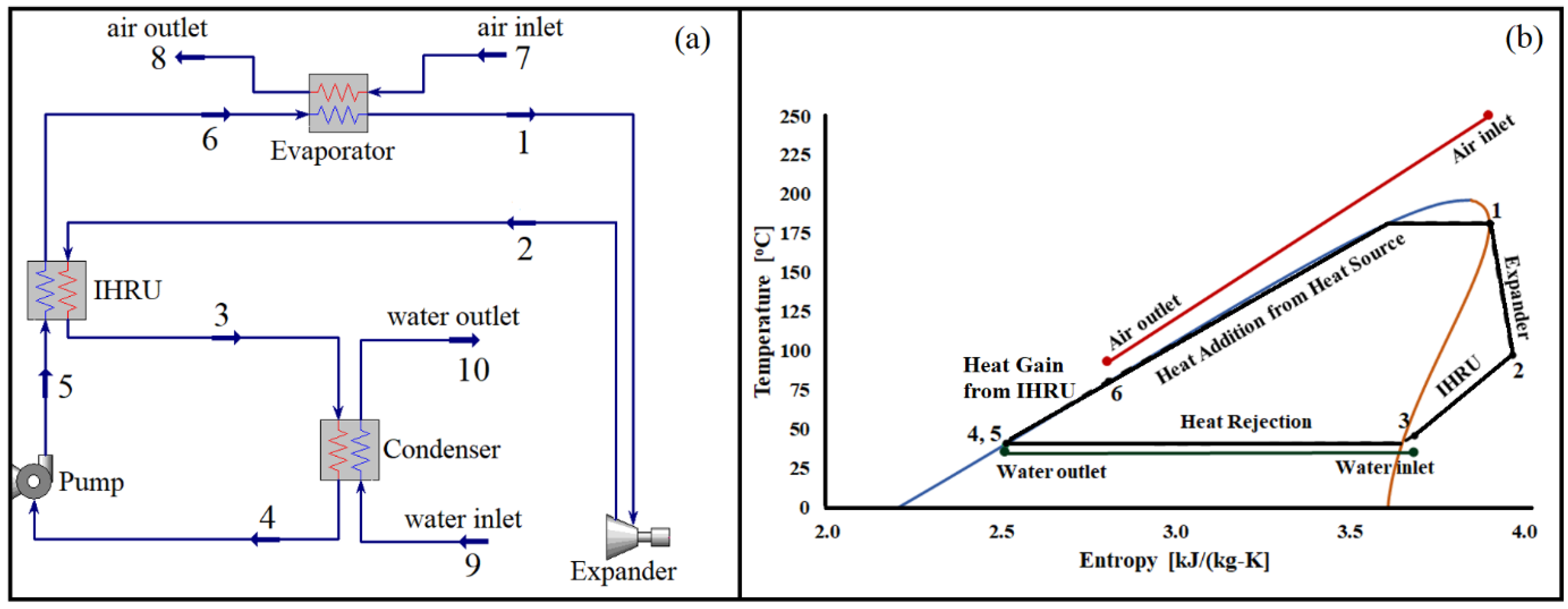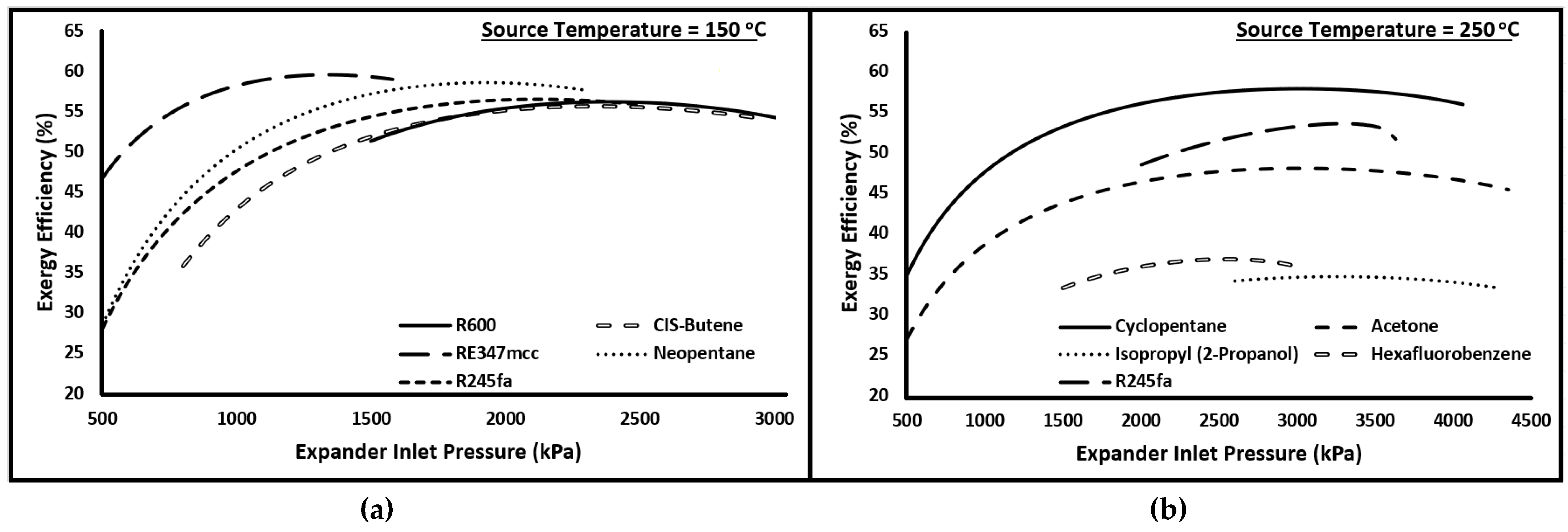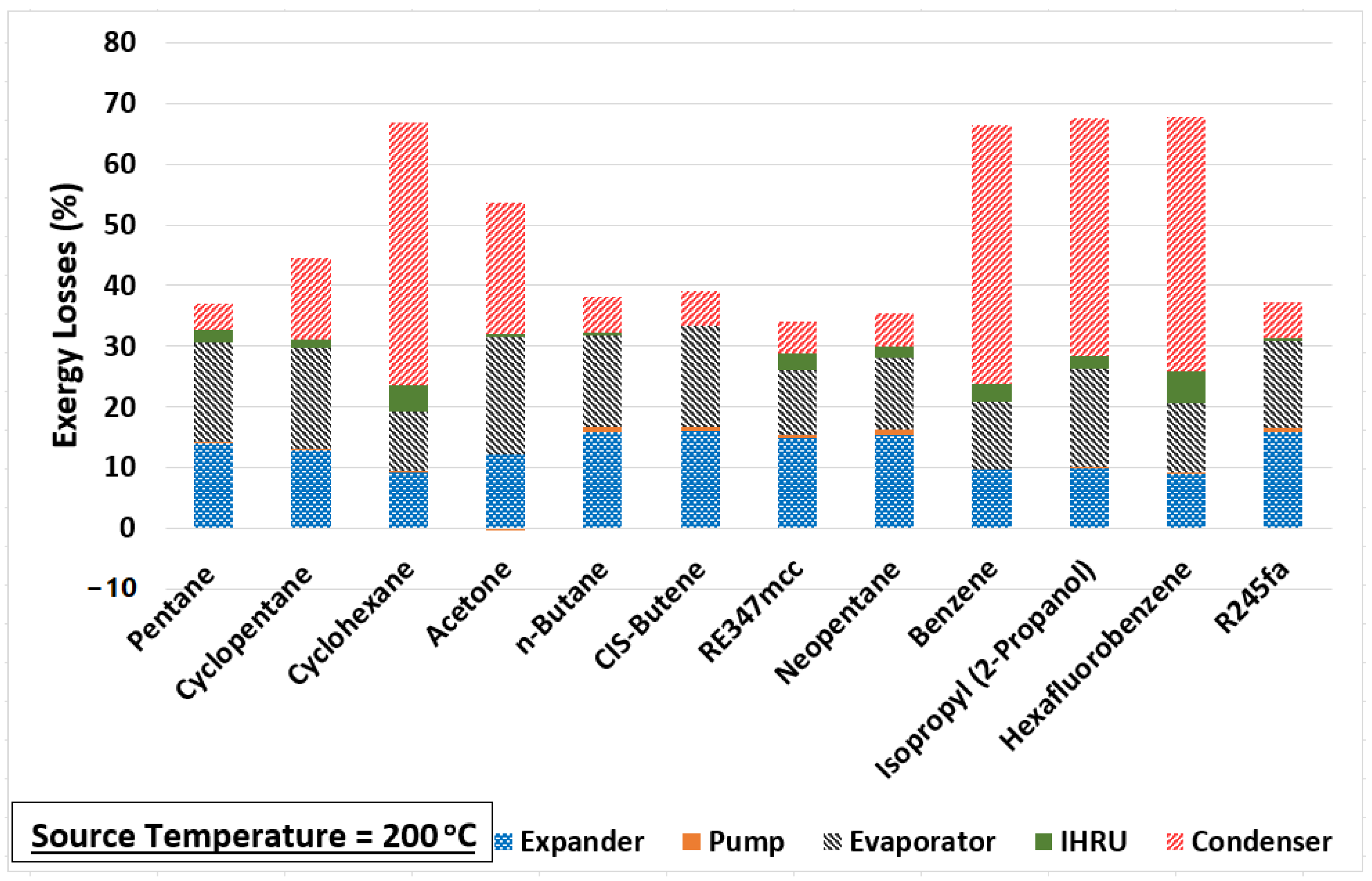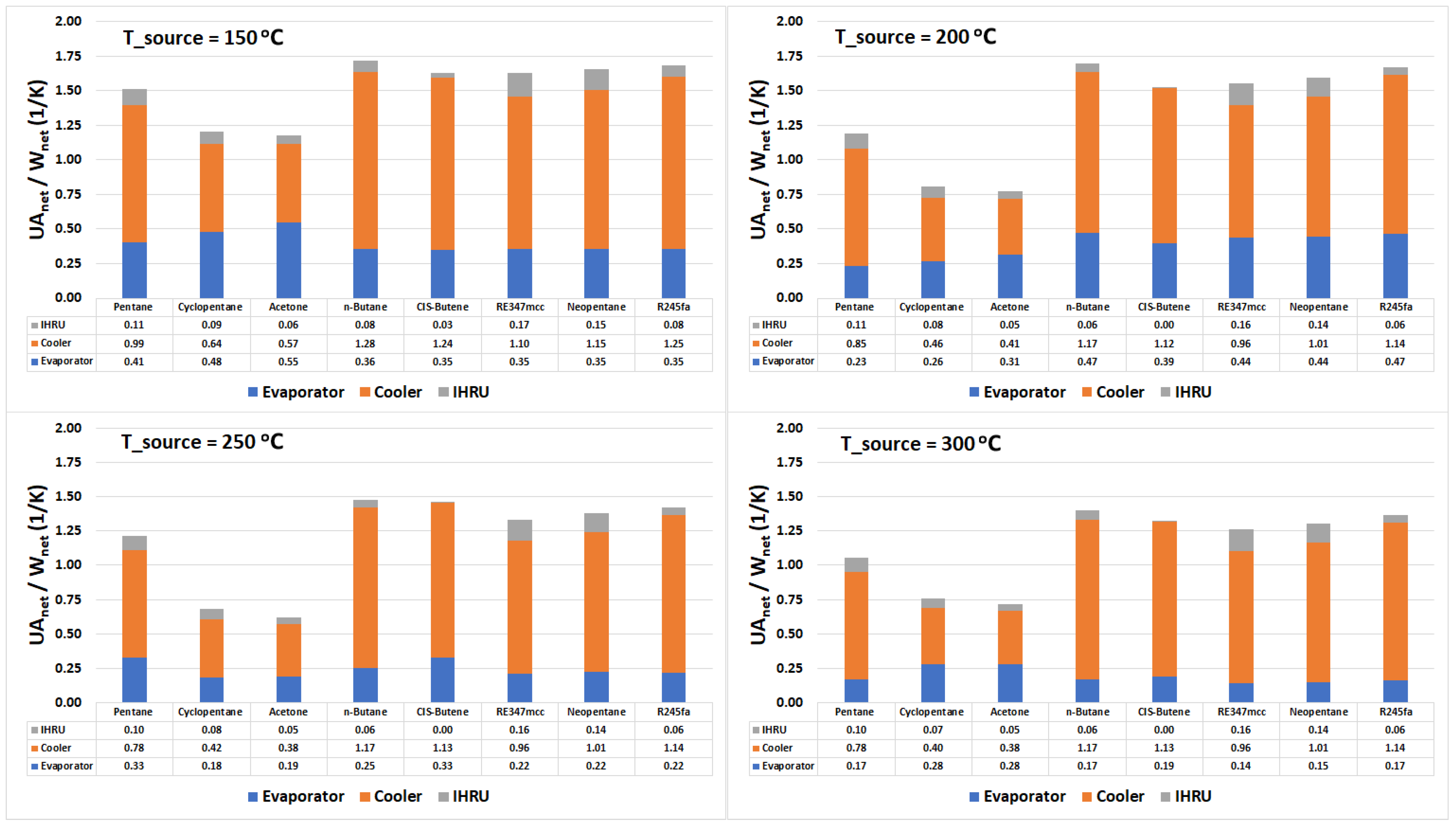Selection of Organic Fluid Based on Exergetic Performance of Subcritical Organic Rankine Cycle (ORC) for Warm Regions
Abstract
:1. Introduction
2. Selection of Organic Fluids and Objectives
3. Description of ORC Configuration
4. Methodology and Operating Parameters
5. Performance Analysis of ORC
6. Results and Discussion
6.1. Optimal Evaporator Pressure
6.2. Effect of the Source Temperature on the Exergy Performance of the Cycle
6.3. Effect of the Organic Fluid on Specific Net Power Output of the Cycle
6.4. Performance of the Internal Heat Recovery Unit in the Cycle
6.5. Heat Exchangers
7. Conclusions
- The critical temperature and pressure of an organic fluid play an important role in its selection for ORC at a given source temperature.
- Cyclohexane, benzene, isopropyl alcohol, and hexafluorobenzene performed very poorly in terms of exergy efficiency when compared to other organic fluids. In comparison to cycle minimum temperature, i.e., 40 °C, these four organic fluids have a boiling point considerably higher. This restricted the pressure to which the working fluid expanded in the expander, which ultimately increased the exergy losses in the condenser.
- At a source temperature of 300 °C, pentane, and cyclopentane outperformed the other organic fluids, whereas cyclopentane (62.2%) had slightly better exergy efficiency than pentane (61.2%). Moreover, Cyclopentane had substantially better SNPO than pentane (nearly 22 kW/kg higher). Also, the net heat exchange area (UA) needed per unit net power output of the plant was considerably smaller for cyclopentane than pentane, this may lead to a smaller plant size.
- At a source temperature of 250 °C, pentane was found to be the best candidate in terms of exergy efficiency followed by RE347mcc and cyclopentane. The heat transfer area needed for RE347mcc was comparable to pentane; however, specific net power output was too low compared to pentane and cyclopentane. Cyclopentane was slightly less efficient than pentane but had significantly higher SNPO and lower UA value. Therefore, cyclopentane is still an attractive option for a source temperature of 250 °C.
- At a source temperature of 200 °C, RE347mcc achieved the highest exergy efficiency followed by neopentane and pentane. However, neopentane and RE347mcc needed higher heat exchanger sizes with substantially lower SNPO values in comparison to pentane. Pentane being 3 percentage points less exergy efficient than RE347mcc is still a good option due to SNPO and UA values.
- At a source temperature of 150 °C, the three best candidates in terms of exergy efficiency were pentane, RE347mcc, and neopentane. However, pentane is still superior due to considerably higher SNPO, and lower UA value compared to RE347mcc and neopentane.
Author Contributions
Funding
Conflicts of Interest
References
- Cook, J.; Oreskes, N.; Doran, P.T.; Anderegg, W.R.; Verheggen, B.; Maibach, E.W.; Carlton, J.S.; Lewandowsky, S.; Skuce, A.G.; Green, S.A.; et al. Consensus on consensus: A synthesis of consensus estimates on human-caused global warming. Environ. Res. Lett. 2016, 11, 048002. [Google Scholar] [CrossRef]
- Yu, H.; Helland, H.; Yu, X.; Gundersen, T.; Sin, G. Optimal design and operation of an Organic Rankine Cycle (ORC) system driven by solar energy with sensible thermal energy storage. Energy Convers. Manag. 2021, 244, 114494. [Google Scholar] [CrossRef]
- Alvi, J.Z.; Feng, Y.; Wang, Q.; Imran, M.; Alvi, J. Modelling, simulation and comparison of phase change material storage based direct and indirect solar organic Rankine cycle systems. Appl. Therm. Eng. 2020, 170, 114780. [Google Scholar] [CrossRef]
- Nemati, A.; Nami, H.; Ranjbar, F.; Yari, M. A comparative thermodynamic analysis of ORC and Kalina cycles for waste heat recovery: A case study for CGAM cogeneration system. Case Stud. Therm. Eng. 2017, 9, 1–13. [Google Scholar] [CrossRef] [Green Version]
- Bao, J.; Zhao, L. A review of working fluid and expander selections for organic Rankine cycle. Renew. Sustain. Energy Rev. 2013, 24, 325–342. [Google Scholar] [CrossRef]
- Wieland, C.; Schifflechner, C.; Dawo, F.; Astolfi, M. The organic Rankine cycle power systems market: Recent developments and future perspectives. Appl. Therm. Eng. 2023, 224, 119980. [Google Scholar] [CrossRef]
- Kishore, R.A.; Priya, S. A Review on Low-Grade Thermal Energy Harvesting: Materials, Methods and Devices. Materials 2018, 11, 1433. [Google Scholar] [CrossRef] [Green Version]
- Park, B.S.; Usman, M.; Imran, M.; Pesyridis, A. Review of Organic Rankine Cycle experimental data trends. Energy Convers. Manag. 2018, 173, 679–691. [Google Scholar] [CrossRef]
- Xu, W.; Zhao, L.; Mao, S.S.; Deng, S. Towards novel low temperature thermodynamic cycle: A critical review originated from organic Rankine cycle. Appl. Energy 2020, 270, 115186. [Google Scholar] [CrossRef]
- Stijepovic, M.Z.; Papadopoulos, A.I.; Linke, P.; Stijepovic, V.; Grujic, A.S.; Kijevčanin, M.; Seferlis, P. Organic Rankine Cycle system performance targeting and design for multiple heat sources with simultaneous working fluid selection. J. Clean. Prod. 2017, 142, 1950–1970. [Google Scholar] [CrossRef] [Green Version]
- Hærvig, J.; Sørensen, K.; Condra, T.J. Guidelines for optimal selection of working fluid for an organic Rankine cycle in relation to waste heat recovery. Energy 2016, 96, 592–602. [Google Scholar] [CrossRef]
- Wang, E.H.; Zhang, H.G.; Fan, B.Y.; Ouyang, M.G.; Zhao, Y.; Mu, Q.H. Study of working fluid selection of organic Rankine cycle (ORC) for engine waste heat recovery. Energy 2011, 36, 3406–3418. [Google Scholar] [CrossRef]
- Wang, X.; Levy, E.K.; Pan, C.; Romero, C.E.; Banerjee, A.; Rubio-Maya, C.; Pan, L. Working fluid selection for organic Rankine cycle power generation using hot produced supercritical CO2 from a geothermal reservoir. Appl. Therm. Eng. 2019, 149, 1287–1304. [Google Scholar] [CrossRef]
- Zhao, Y.; Gao, C.; Li, C.; Sun, J.; Wang, C.; Liu, Q.; Zhao, J. Energy and Exergy Analyses of Geothermal Organic Rankine Cycles Considering the Effect of Brine Reinjection Temperature. Energies 2022, 15, 6230. [Google Scholar] [CrossRef]
- Desai, N.B.; Bandyopadhyay, S. Thermo-economic analysis and selection of working fluid for solar organic Rankine cycle. Appl. Therm. Eng. 2016, 95, 471–481. [Google Scholar] [CrossRef]
- Franchini, G.; Perdichizzi, A.; Ravelli, S.; Barigozzi, G. A comparative study between parabolic trough and solar tower technologies in Solar Rankine Cycle and Integrated Solar Combined Cycle plants. Sol. Energy 2013, 98, 302–314. [Google Scholar] [CrossRef]
- Siddiqui, M.E.; Almatrafi, E.; Bamasag, A.; Saeed, U. Adoption of CO2-based binary mixture to operate transcritical Rankine cycle in warm regions. Renew. Energy 2022, 199, 1372–1380. [Google Scholar] [CrossRef]
- Xu, W.; Zhao, R.; Deng, S.; Zhao, L.; Mao, S.S. Is zeotropic working fluid a promising option for organic Rankine cycle: A quantitative evaluation based on literature data. Renew. Sustain. Energy Rev. 2021, 148, 111267. [Google Scholar] [CrossRef]
- Abadi, G.B.; Kim, K.C. Investigation of organic Rankine cycles with zeotropic mixtures as a working fluid: Advantages and issues. Renew. Sustain. Energy Rev. 2017, 73, 1000–1013. [Google Scholar] [CrossRef]
- Liang, Z.; Liang, Y.; Luo, X.; Chen, J.; Yang, Z.; Wang, C.; Chen, Y. Synthesis and simultaneous optimization of multi-heat source multi-pressure evaporation organic Rankine cycle with mixed working fluid. Energy Convers. Manag. 2022, 251, 114930. [Google Scholar] [CrossRef]
- Ganjehsarabi, H. Mixed refrigerant as working fluid in Organic Rankine Cycle for hydrogen production driven by geothermal energy. Int. J. Hydrogen Energy 2019, 44, 18703–18711. [Google Scholar] [CrossRef]
- Wu, Y.; Zhu, Y.; Yu, L. Thermal and economic performance analysis of zeotropic mixtures for Organic Rankine Cycles. Appl. Therm. Eng. 2016, 96, 57–63. [Google Scholar] [CrossRef]
- Oyewunmi, O.A.; Markides, C.N. Thermo-Economic and Heat Transfer Optimization of Working-Fluid Mixtures in a Low-Temperature Organic Rankine Cycle System. Energies 2016, 9, 448. [Google Scholar] [CrossRef] [Green Version]
- Sarkar, J. Property-based selection criteria of low GWP working fluids for organic Rankine cycle. J. Braz. Soc. Mech. Sci. Eng. 2017, 39, 1419–1428. [Google Scholar] [CrossRef]
- Sami, S.M. ORC for low temperature power generation with low GWP refrigerants. Int. J. Ambient Energy 2012, 33, 2–8. [Google Scholar] [CrossRef]
- Minor, B.; Kontomaris, K.; Hydutsky, B. Nonflammable Low GWP Working Fluid for Organic Rankine Cycles. In Proceedings of the ASME Turbo Expo 2014, Düsseldorf, Germany, 16–20 June 2014; Volume 3B. [Google Scholar] [CrossRef]
- Bahrami, M.; Pourfayaz, F.; Kasaeian, A. Low global warming potential (GWP) working fluids (WFs) for Organic Rankine Cycle (ORC) applications. Energy Rep. 2022, 8, 2976–2988. [Google Scholar] [CrossRef]
- Herath, H.M.D.P.; Wijewardane, M.A.; Ranasinghe, R.A.C.P.; Jayasekera, J.G.A.S. Working fluid selection of Organic Rankine Cycles. Energy Rep. 2020, 6, 680–686. [Google Scholar] [CrossRef]
- Hijriawan, M.; Pambudi, N.A.; Biddinika, M.K.; Wijayanto, D.S.; Kuncoro, I.W.; Rudiyanto, B.; Wibowo, K.M. Organic Rankine Cycle (ORC) in geothermal power plants. J. Phys. Conf. Ser. 2019, 1402, 044064. [Google Scholar] [CrossRef]
- Toffolo, A.; Lazzaretto, A.; Manente, G.; Paci, M. A multi-criteria approach for the optimal selection of working fluid and design parameters in Organic Rankine Cycle systems. Appl. Energy 2014, 121, 219–232. [Google Scholar] [CrossRef]
- Aboelwafa, O.; Fateen, S.E.K.; Soliman, A.; Ismail, I.M. A review on solar Rankine cycles: Working fluids, applications, and cycle modifications. Renew. Sustain. Energy Rev. 2018, 82, 868–885. [Google Scholar] [CrossRef]
- Shahrooz, M.; Lundqvist, P.; Nekså, P. Natural refrigerants for low temperature power cycles. In Proceedings of the 13th IIR Gustav Lorentzen Conference on Natural Refrigerants (GL2018), Valencia, Spain, 18–20 June 2018; pp. 1373–1380. [Google Scholar] [CrossRef]
- Shahrooz, M.; Lundqvist, P.; Nekså, P. Performance of binary zeotropic mixtures in organic Rankine cycles (ORCs). Energy Convers. Manag. 2022, 266, 115783. [Google Scholar] [CrossRef]








| Name | Chemical Formula/Alternative Name | Critical Pressure (MPa) | Critical Temperature (°C) | Normal Boiling Temperature (°C) | |
|---|---|---|---|---|---|
| 1 | Pentane | C5H12 | 3.4 | 197 | 36.1 |
| 2 | Cyclopentane | C5H10 | 4.5 | 239 | 49.2 |
| 3 | Cyclohexane | C6H12 | 4.1 | 281 | 80.8 |
| 4 | Acetone | C3H6O | 4.9 | 235 | 56.1 |
| 5 | n-Butane | R600 | 3.8 | 152 | −0.5 |
| 6 | CIS-Butene | - | 4.2 | 162 | 3.7 |
| 7 | RE347mcc | HFE-7000 | 2.5 | 165 | 34.2 |
| 8 | Neopentane | C5H12 | 3.2 | 161 | 9.5 |
| 9 | Benzene | C6H6 | 4.9 | 289 | 80.1 |
| 10 | Isopropyl Alcohol | C3H8O | 5.4 | 236 | 82.5 |
| 11 | Hexafluorobenzene | C6F6 | 3.3 | 244 | 80.1 |
| 12 | R245fa | C3H3F5 | 3.7 | 154 | 15.3 |
| Parameter | Value |
|---|---|
| Heating medium (source) | Air with inlet temperature 150–300 °C and 101 kPa at 1 kg/s |
| Cooling medium (sink) | Water at 35 °C and 101 kPa |
| Dead state condition | 35 °C and 101 kPa |
| Expander inlet pressure | Up to 90% of critical pressure of the working fluid |
| Expander inlet temperature | Saturation temperature corresponding to expander pressure |
| Pump inlet temperature | 40 °C |
| Pump inlet pressure | 101 kPa or saturation pressure at 40 °C if it is above 101 kPa |
| Pump adiabatic efficiency | 0.9 |
| Expander adiabatic efficiency | 0.8 |
| Minimum PPTD (evaporator) | 10 °C |
| Minimum PPTD (condenser) | 5 °C |
| Minimum PPTD (IHRU) | 5 °C |
| Organic Fluid | Source Temperature | |||
|---|---|---|---|---|
| 150 °C | 200 °C | 250 °C | 300 °C | |
| Pentane | 61.7 | 62.9 | 67.7 | 61.2 |
| Cyclopentane | 52.6 | 55.5 | 57.9 | 62.2 |
| Cyclohexane | 17.9 | 33.2 | 39.9 | 44.0 |
| Acetone | 42.5 | 46.5 | 48.1 | 51.1 |
| n-Butane | 56.2 | 61.7 | 53.8 | 47.4 |
| CIS-Butene | 55.7 | 60.9 | 57.6 | 50.6 |
| RE347mcc | 59.6 | 65.9 | 58.2 | 52.1 |
| Neopentane | 58.6 | 64.5 | 56.7 | 50.7 |
| Benzene | 19.1 | 33.5 | 39.5 | 42.1 |
| Isopropyl (2-Propanol) | 22.4 | 32.5 | 34.7 | 37.4 |
| Hexafluorobenzene | 18.5 | 32.3 | 36.9 | 39.2 |
| R245fa | 56.6 | 62.7 | 53.5 | 48.4 |
Disclaimer/Publisher’s Note: The statements, opinions and data contained in all publications are solely those of the individual author(s) and contributor(s) and not of MDPI and/or the editor(s). MDPI and/or the editor(s) disclaim responsibility for any injury to people or property resulting from any ideas, methods, instructions or products referred to in the content. |
© 2023 by the authors. Licensee MDPI, Basel, Switzerland. This article is an open access article distributed under the terms and conditions of the Creative Commons Attribution (CC BY) license (https://creativecommons.org/licenses/by/4.0/).
Share and Cite
Siddiqui, M.E.; Almatrafi, E.; Saeed, U.; Taimoor, A.A. Selection of Organic Fluid Based on Exergetic Performance of Subcritical Organic Rankine Cycle (ORC) for Warm Regions. Energies 2023, 16, 5149. https://doi.org/10.3390/en16135149
Siddiqui ME, Almatrafi E, Saeed U, Taimoor AA. Selection of Organic Fluid Based on Exergetic Performance of Subcritical Organic Rankine Cycle (ORC) for Warm Regions. Energies. 2023; 16(13):5149. https://doi.org/10.3390/en16135149
Chicago/Turabian StyleSiddiqui, Muhammad Ehtisham, Eydhah Almatrafi, Usman Saeed, and Aqeel Ahmad Taimoor. 2023. "Selection of Organic Fluid Based on Exergetic Performance of Subcritical Organic Rankine Cycle (ORC) for Warm Regions" Energies 16, no. 13: 5149. https://doi.org/10.3390/en16135149






